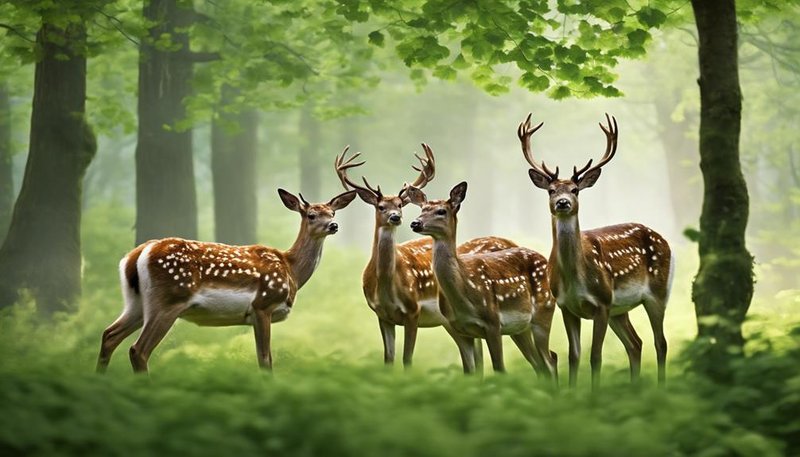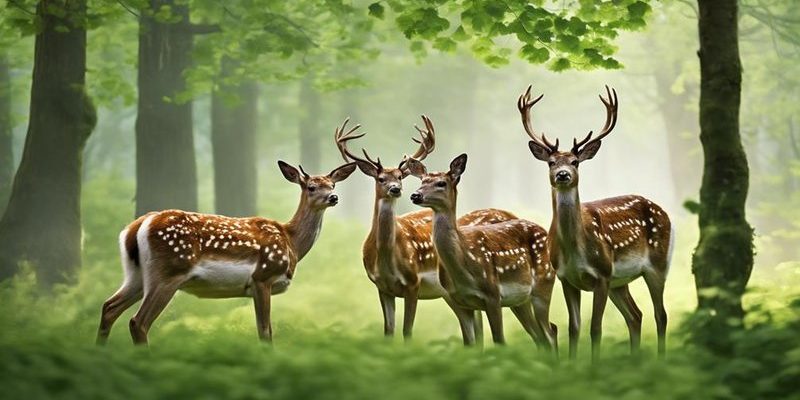
You might be wondering why it’s important to differentiate these animals. After all, they’re all part of the same natural family, right? Well, understanding their differences helps us appreciate the diversity in wildlife and contributes to conservation efforts. Plus, the more you know, the better equipped you’ll be for your next nature hike or wildlife-watching adventure!
1. Roe Deer
Roe deer are often mistaken for fallow deer due to their similar size and shape. However, the roe deer is typically smaller, standing about 2 feet tall at the shoulder. Their fur is usually a more uniform reddish-brown color, lacking the distinct spots of the fallow deer. One key feature to look out for is the roe deer’s white behind, which becomes especially noticeable when they’re startled.
Roe deer are quite shy and prefer dense woodland areas, making them a bit harder to spot compared to more social fallow deer. They’re also known for their short, stocky legs and pointed ears. If you ever see a lone deer in a forest, take a moment to observe its behavior. Does it seem more cautious? That could very well be a roe deer!
2. Sika Deer
The sika deer is another close relative often confused with the fallow deer. Native to East Asia, they have a similar size and shape but can be identified by their slightly elongated bodies and more prominent antlers in males. Unlike the fallow deer, sika deer have a unique coat that can change with the seasons, ranging from a rich reddish-brown in summer to a grayish-brown in winter.
A fascinating feature of the sika deer is its vocalization. They’re known to make a variety of sounds, from barking to whistle-like calls. So, if you’re out in the wild and hear an unusual sound, it might just be a sika deer communicating with its mates!
3. Red Deer
Red deer are among the largest deer species, with males reaching up to 4 feet tall at the shoulder. While they may share the same habitat with fallow deer, they can be distinguished by their impressive antlers, which are much larger and have more tines (points) than those of the fallow deer.
Their coat is a solid brown, with a lighter patch on their backside. If you see a large deer in open fields, take a closer look—it might just be a red deer! These majestic creatures are social animals, often seen in groups during mating season.
4. Whitetail Deer
The whitetail deer is one of the most common deer species in North America. They are easily recognizable by the white underside of their tail, which they raise when they run away, flashing it like a warning sign to other deer. In contrast to the fallow deer’s spotted coat, whitetail deer have a more uniform brown coloration.
While they tend to be slightly leaner than fallow deer, their large, expressive eyes and graceful posture make them equally captivating. If you ever find yourself in a suburban area with deer wandering around, chances are they’re whitetails, often seen grazing in parks or backyards.
5. Axis Deer
The axis deer, also known as chital, is famed for its beautiful spotted coat—similar to that of the fallow deer. These animals are native to India and have a more slender build compared to the fallow deer. An easy way to distinguish them, however, is their distinctive white throat and the white markings on their face.
Axis deer are quite social, often found in herds, which can include both males and females. If you’re in a wildlife sanctuary and see a group of spotted deer, keep an eye out for their beautiful patterns and alert behaviors!
6. Black-tailed Deer
The black-tailed deer is another cousin of the fallow deer, primarily found along the Pacific Coast of North America. They share similar body shapes, but the black-tailed deer is typically darker, with a prominent black tail. Their coats are brownish with lighter underbellies, distinguishing them from the fallow deer’s varied coloration.
One interesting fact about black-tailed deer is they can often be found in forested areas, foraging for food among the underbrush. If you’re hiking in these regions, you might catch sight of their agile movements as they navigate through the trees.
7. Muntjac Deer
The muntjac deer, or barking deer, is a relatively small species that can be confused with the fallow deer due to its size and build. However, they have a unique, stocky body and a somewhat more elongated face. Muntjacs are known for their barking sounds, which gives them their nickname.
What sets them apart from the fallow deer is their lack of antlers in females and much smaller antlers in males. If you ever see a small, alert deer that seems a bit more vocal than its counterparts, it just might be a muntjac enjoying the woodland serenade.
8. Pere David’s Deer
Also known as Elaphurus davidianus, the Pere David’s deer has a unique, somewhat exotic appearance that makes it easy to spot. Though they’re similar in size to the fallow deer, they have a more elongated body and could be mistaken for a longer-legged cousin.
They are critically endangered and are known for their unique adaptations to wetland habitats, such as elongated hooves. Spotting a Pere David’s deer is rare, making them a special find for wildlife enthusiasts. If at a conservation area, take a moment to appreciate their majestic features!
9. Hispaniolan Dwarf Goat
Though not a deer, the Hispaniolan dwarf goat can sometimes be mistaken for a fallow deer due to its small size and gentle demeanor. These goats are often seen grazing in similar environments. The primary difference is their noticeable beard and rounded build, which clearly set them apart.
These goats are social and often live in small groups, making them a delightful sight at farms or petting zoos. If you ever feel unsure about a spotted creature, look for the beard—it could be a friendly goat rather than a shy fallow deer!
10. Impala
Last but not least, the impala may be one of the most elegant animals you could mistake for a fallow deer. Native to Africa, these graceful creatures exhibit similar spotted coats but are generally taller and leaner. Impalas are known for their incredible leaping ability, often soaring several feet in the air to escape predators.
You’ll find that while fallow deer may resemble them at first glance, the impala’s longer legs and larger build set them apart. If you find yourself on a safari, watch them in action—it’s a breathtaking sight!
In conclusion, while the fallow deer is a stunning creature in its own right, there’s a whole world of similar animals that share their habitats. Understanding how to tell them apart not only enhances your wildlife experiences but also deepens your appreciation for nature. Next time you’re out exploring, keep an eye out for these animals—who knows what delightful discoveries await?

